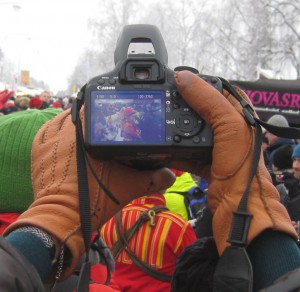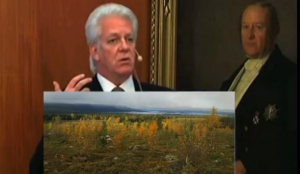A recent foray into fieldwork saw myself and Britt Kramvig travelling to the annual Sami winter market in Jokkmokk in northern Sweden. Jokkmokk is the seat of the S wedish Sami parliament, and it also has one of the most important Sami colleges for traditional crafts or what we might call applied arts. The 409th annual Sami winter market, and its associated conference promised to be a gathering of Sami from across Sápmi, the Sami territories that reach from mid-Norway through Sweden, Finland and Russia down to the Kola peninsula, and a major tourist attraction.
wedish Sami parliament, and it also has one of the most important Sami colleges for traditional crafts or what we might call applied arts. The 409th annual Sami winter market, and its associated conference promised to be a gathering of Sami from across Sápmi, the Sami territories that reach from mid-Norway through Sweden, Finland and Russia down to the Kola peninsula, and a major tourist attraction.
 Our aim was to see what kind of tourism the Sami winter market offers, who would be there, what was on offer. While we saw plenty of archetypal tourist activities – such as cameras thrust in the faces of traditionally-clad reindeer herders – we also saw protest placards in shop windows and an exhibition about environmental protest against prospecting in reindeer herding areas. We have discussed this briefly in our Arctic Encounters blog, and we will be doing further fieldwork and writing more about it later, but the point in this blog is to note that tourism here is immediately thrust up against other industries in competition for resources. Reindeer herders can accommodate some kinds of tourism, but accommodating is not an option if mining is to expand, not only because open-cast mining takes away the land that reindeer graze on, but because the roads and other infrastructure that serve the mines take out many animals in accidents, as a herders’ representative explained during the conference. The repercussions may spread beyond a little local disruption.
Our aim was to see what kind of tourism the Sami winter market offers, who would be there, what was on offer. While we saw plenty of archetypal tourist activities – such as cameras thrust in the faces of traditionally-clad reindeer herders – we also saw protest placards in shop windows and an exhibition about environmental protest against prospecting in reindeer herding areas. We have discussed this briefly in our Arctic Encounters blog, and we will be doing further fieldwork and writing more about it later, but the point in this blog is to note that tourism here is immediately thrust up against other industries in competition for resources. Reindeer herders can accommodate some kinds of tourism, but accommodating is not an option if mining is to expand, not only because open-cast mining takes away the land that reindeer graze on, but because the roads and other infrastructure that serve the mines take out many animals in accidents, as a herders’ representative explained during the conference. The repercussions may spread beyond a little local disruption.
In the 1980s, Norwegian plans to dam the Alta river for hydro-electric power sparked an uprising that eventually led to the founding of the Sami parliament, and an apology from the Norwegian king for the disgraceful treatment of the Sami by the Norwegian state over the centuries. In Sweden, the multiple-dams on the Lule river provide up to a fifth of Sweden’s electricity needs, and mining has been so extensive in Kiruna that the city will now be moved to safer ground.
After years of accommodating, and accepting the use of grazing lands as military rifle ranges, it seems possible now that resistance is growing. One reason is the crass exploitation exercised by the mining companies supported by central government in Stockholm. There are questions to be asked about why Sweden would want to give away its natural resources, barely taxing foreign companies to come into the North and take away minerals. And why, if environmental sustainability is given the highest priority in Swedish law, should limited-term extractive industries be prioritised over timeless reindeer herding? But there were also practices with extraordinarily colonial features that seem almost designed to spark revolt.
In Gallok/Kallak, protesters blockading a road to prevent iron-ore prospecting close to the Laponia World Heritage Site were smart enough to buy shares in the prospecting company, a British firm called Beowulf mining. At the shareholders meeting, they heard the CEO, Sinclair Poulton, state unashamedly that there was no need to worry about the responses of local people to prospecting. Showing a picture of a forested landscape,  he asked ‘what local people?’ Their response was a website and a movement called ‘What local people?‘, featuring portraits of the many local people who felt ignored and disrespected by the mining project. Protests over the potential mines grew, garnering concerns about pollution of watercourses, noise and disturbance to wildlife, increased traffic, dangers to reindeer, and so forth. The situation is ongoing, and Britt and I will be returning to Gallok this summer for further fieldwork, and co-operating with Swedish researchers also following this episode with interest.
he asked ‘what local people?’ Their response was a website and a movement called ‘What local people?‘, featuring portraits of the many local people who felt ignored and disrespected by the mining project. Protests over the potential mines grew, garnering concerns about pollution of watercourses, noise and disturbance to wildlife, increased traffic, dangers to reindeer, and so forth. The situation is ongoing, and Britt and I will be returning to Gallok this summer for further fieldwork, and co-operating with Swedish researchers also following this episode with interest.
The focus on tourism in Arctic Encounters may look narrow, but looking carefully opens up a whole world of relations. Across the North, tourism is both growing, and growing in diversity. The category Tourism disguises a complex array of different practices, from indigenous hospitality to corporate commercialism, bringing diverse challenges and tensions. Arctic Encounters has also been examining the rapid expansion of whale watching enterprises, barely regulated, often unsafe and potentially dangerous for the whales, as well as the watchers. Britt Kramvig and Berit Kristoffersen will be following the whales and their watchers further this year, and linking the expanding watching-industry with the changing habits of whales due to ocean disturbances induced by climate change.
In asking about travel/writing and the Arctic, we are addressing questions about indigenous rights, notions of land and property, corporate capitalism and extractive industries – including minerals as well as carboniferous fuels – and energy production more generally. In a final blog in this series, I will be linking the European Arctic across to the circumpolar Arctic, and touching on the representations that conjure the notion of Arctic worlds from elsewhere.
many of the issues that you have touched on in your posts on tourism speak to the condition of indigenous groups in the tropics–at least on the little pacific island where i have been working. issues of tourism as a relatively non-extractive and some would think “green” industry versus manufacturing or natural resource exploitation, scale and origin of investments, and division of labor in the tourist economy, not to mention the constant promise of protest or revolt, mark encounters between tourism (i here use the noun as a stand in for an entire network or assemblage, not just a set of practices) and indigenous communities on taiwan’s east coast, the differences in climate, constitutional arrangements, and community organization notwithstanding. because the tourist development here is just beginning, i’ve often wondered about the possibility of something more than just comparative work. some sense of the experience of people in places like costa rica, for example, would be useful for local communities who have to sort out what the industry could mean for them. lest this seem like a completely applied exercise, the stakes are important for anthropologists, too: there are 3 of us working here in a’tolan, which is at the center of many contested visions of a tourist economic future. our work is somewhat correlated with the industry, yet we often ignore it around us. coincidence?